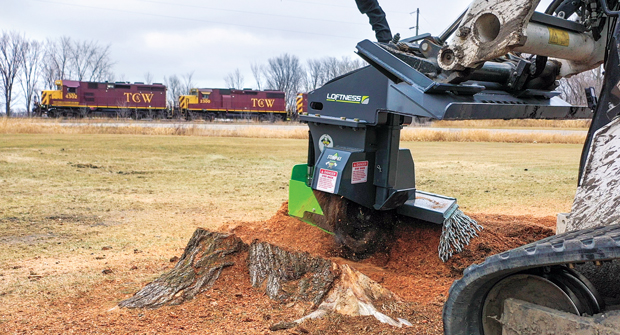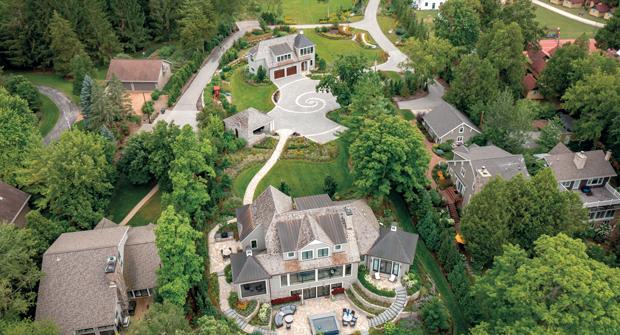With so many attachment options becoming mainstays in the average landscape pro’s arsenal of equipment, finding the ones that perfectly suit a jobsite’s needs can be a real stumper.
Stump grinding/cutting especially can be tricky, as it’s often a more niche job compared to moving materials, grading or digging. However, when the time comes to remove that giant slab of wood lodged in the ground, having the right tools on hand can save plenty of time, manpower and headaches.
Choose your style
When it comes to skid-steer stump grinding, two popular types to choose from include the fixed and swinging styles. Clint Major, product development coordinator for the attachment manufacturer Loftness, says his company specializes in the fixed style.
“It’s going to be more productive because you can just come into the stump, and you just drive the skid loader back and forth,” he says. “You’ve got pretty good visibility when you’re grinding on the stump. We do have what we call the extended reach boom, so it puts that wheel farther out ahead of you.”
The swinging style has a cutting wheel mounted on a pivoting arm or mechanism, allowing it to swing left and right independently of the skid-steer. This type of attachment can be beneficial for accessing tight areas the skid-steer can’t maneuver in.
Major says the type of jobsite being worked on is also a big factor for choosing an attachment. Fixed style requires the skid-steer to move more, meaning it may not be the best option when working on a sensitive lawn.
“We’re going to disturb the grass a little more than the swinging type,” he says. “But, overall productivity, the rigid style is quicker.”
Cost and simplicity can also come into play, as the swinging style options are often larger and more complex, meaning they can be more expensive and difficult to maintain.
A dedicated approach
While attachments are more versatile and take up less room on a trailer, if stump cutting is a recurring task that needs some extra attention, a dedicated machine may be the right option.
“If you’re going to tackle 30-inch oak stumps on a consistent basis, an attachment is probably not your best application or use of time for that, “ says Collin Schmidt, associate product manager at Vermeer. “It can do it, and we’re not going to say no to it, but if you’re really analyzing your use of time, that’s probably not your best use case.”
And while a dedicated machine may require some extra upfront investment, there’s still plenty of customization and equipment options that can help match the machine to the job. Schmidt says Vermeer offers both wheeled and tracked machines to better handle the jobsite terrain, and like attachments, there’s a range of horsepower options available.
Check out your choice
Choosing between a dedicated machine and an attachment isn’t always easy, and each side is seeing advancements that only increase their specialization and capabilities.
“The attachment market is continuing to get bigger and bigger — our mini skid-steers and our ATXs keep advancing, and the hydraulic flow of those machines continues to advance, allowing us to get more applications inside of them,” Schmidt says.
That’s why both Schmidt and Major recommend getting expert advice and hands-on experience to find the best fit. Major, for example, says customers who are dedicated to getting a stump grinding attachment can work with a Loftness dealer to get some training and equipment demos.
“If a potential customer is seriously considering one of our attachments, we’re happy to line up a demo or training whenever possible,” Major says.
Similarly, for those interested in a stump cutting machine, Schmidt recommends finding the nearest dealer and working with them, and he says Vermeer dealers can do equipment demos to showcase their options.


